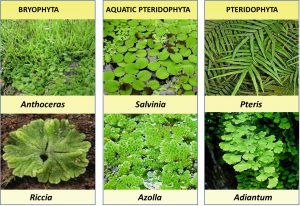Botany Notes On – Distribution Of Cryptogams – For W.B.C.S. Examination.
Algae occur in fresh water, hot water streams, sea, on moist land (soil), stems of plants and stones. Some algae are found on mud, e.g. Chara.Continue Reading Botany Notes On – Distribution Of Cryptogams – For W.B.C.S. Examination.
Few algae occur on banks of lakes and ponds, e.g. Rivularia. Some algae complete their life cycle while living at 70-80°C temperature in hot water stream. Some blue-green algae survive at 85°C. Some algae are found floating on water, e.g. diatoms and Volvox.
Some algae are found floating on band of pond, e.g. Spirogyra. Some algae are epiphytes i.e. they grow on other plants (algae or branches of trees) e.g. Oedogonium. Protoderma, an algae grows on back of tortoise and Cladophora lives upon snail. In addition some algae live inside the animal bodies e.g. Zoochlorella is found in Hydra. Sometimes algae are parasitic e.g. Cephaeleuros is parasite on leaves of tea and coffee.
Phyllobium sphagnicolum (a green algae) is parasite on Sphagnum (a moss) and Rhodochytrium spilanthidis (a green algae) is parasitic on leaves of Ambrosia. Oscillatoria and Simonsiella live as mild parasites in the intestine of man and other animals. Some algae are marine, e.g. Sargassum and Fucus.
Various kinds of algae grow on damp soil, e.g. Vaucheria. Algae are found inside the soil upto one metre depth. Algae, are also found on bark of trees, walls and stones etc. e.g. Scytonema. Sometimes snow gives different colours on account of algae occurring in snow, e.g. Chlamydomonas.
Nostoc and Anabaena are found in the body of Anthoceros and Azolla plant respectively. Anabaena with Azolla is found in rice field in India. Also these algae live in coralloid roots of cycas. Some algae live symbiotically with fungi in lichens. Cladophora may live in symbiotic relationship with sponge (Eplydatea fuiritalis). Some blue green algae live in protozoans and are called cynallele.
Trichodesmium erythrium (myxophyceae) lives in red sea imparting it red shade. In ponds near temples in India where old flowers are thrown, Spirogyra is dominantly found.
Spirogyra is fresh water olive green algae. It is known as ‘pondscum’, ‘pond silk’ or water silk. It is generally found in stagnant reservoirs, ditches & streams. In India, S. jogens, S. crassata, S. elongata, S. communis, S. condensata, S. parvula, S. microspora, S. sahnii, S. indica etc. are used.
Fungi: Fungi are found everywhere. Due to lack of chlorophyll pigments, they are unable to synthesize their food. Therefore, they are either parasites or saprophytes. Some fungi may grow on cow dung (Coprophilous fungi) or may occur symbiotically. Parasitic fungi take their food from host plants and with the death of host, are caused the death of parasitic fungi.
Such fungi are called obligate parasites. Some fungi which are usually parasitic but after the death of host plant, are able to absorb their good from the decaying body of the plant are called facultative saprophytes.
Those fungi which always take their food from decaying organic matter (decaying leather, food, gems, jellies, bread, fruits etc.) are called obligate saprophytes and those fungi which are usually saprophytes but can live parasitically under some conditions are called facultative parasites.
Those parasites which grow on the surface of the host cells and absorb their food through haustoria are called ectoparasites (ecotophytic parasites) while those parasites which enter into the tissues of the host are called endoparasites or endophytic parasites.
Some fungi, e.g. Dactylella and Arthrobotrys derive their food from protozoans, eelworms and rotifers. Such fungi are called predaceous fungi. Some fungi live symbiotically with algae (in lichens). Some fungi live in the roots of higher plants, e.g. in the roots of Pinus.
This type of symbiotic relationship is called mycorrhiza. Rhizopus is saprophytic fungus living on dead organic matters. Its mycelium is made up of thin, white hyphae growing on pickles, vegetables neglected shoes, specially in rains. It may become parasitic under some conditions causing softrot in sweet potato.
In laboratory it can be grown within 2-3 days on a moist piece of bread covered by jar. Yeast is a saprophyte fungus found on substratum which rich is in sugars e.g. sugarcane, juice, fruits, milk some species are found on animal excreta.
Please subscribe here to get all future updates on this post/page/category/website


 Toll Free 1800 572 9282
Toll Free 1800 572 9282  mailus@wbcsmadeeasy.in
mailus@wbcsmadeeasy.in



















































































































